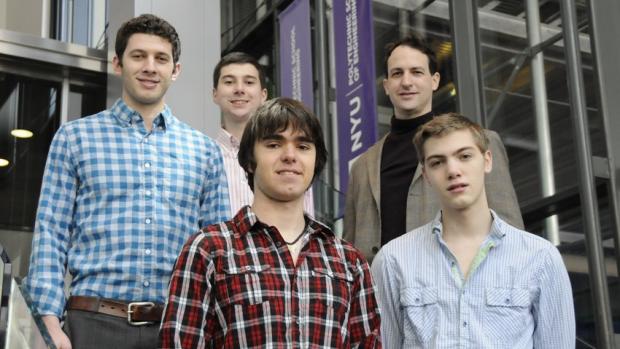New York University School of Engineering Students Win Prize to Revolutionize the Technology of Diving

NEW YORK—New York University Polytechnic School of Engineering freshmen Patrick Nave and Patrick Gumusoglu, both physics majors, won $1,000 to advance their process by which oxygen and nitrogen can be harnessed in solid form. The students hope to use that technology to devise a replacement for the bulky, heavy, and expensive compressed-gas tanks typically used by sport divers. “Solid Air,” as they are calling their proposed product, might also have the potential to be used by fire fighters and by the 800,000 people in the U.S. alone who use supplemental oxygen tanks in their homes to treat such condition as emphysema.
“Standard chemical reactions are involved,” Gumusoglu explains, “and our system would be a great deal lighter, smaller, and cheaper than those used now.” The technology is patent-pending, under an application filed by Nave.
The pair formulated their idea as part of an assignment for Industry Professor David Lefer’s required freshman Innovation and Technology Forum, whose mission is to immerse students in and get them comfortable with thinking creatively in the fields of science, mathematics and engineering.
“My students are required to solve a problem using a new technology,” said Lefer, an historian and former journalist. “The key to doing well is not just to come up with an idea, but also to test it in the marketplace. Using Lean Startup principles, students must interview at least a dozen potential customers to see if their invention is something someone would ultimately want to buy. They also help budding entrepreneurs figure out whether to continue on the path they are following, or whether they should pivot and try a new direction.”
Lefer offered a $500 cash prize to the team with the most compelling idea, and Suneris, a company co-founded by NYU School of Engineering senior Joe Landolina to develop and market an instant wound-healing gel, contributed an additional $500. After Lefer winnowed the 60 entrants down to five finalists, the entire class of 300 voted, choosing “Solid Air” by a wide margin.
Nave and Gumusoglu will be using the $1,000 to produce prototypes, and Lefer, for one, is confident that their product could be a viable one with great commercial potential.
“They had gone above and beyond the assignment by interviewing several dozen people in the SCUBA business,” he explained. “And they had several video clips of expert divers and business owners discussing how revolutionary this new technology could be.”
The Innovation in Engineering and Technology Forum lays the foundation for building the next generation of global innovators and inventors. Students attend lectures by notable guest lecturers on front-burner issues like green technology, microfinance, patent law and biotechnology. They learn communications, teambuilding, and business skills to prepare them for a university dedicated to what it calls i-squared-e: invention, innovation, and entrepreneurship. The course introduces them to a rigorous multidisciplinary approach that will guide them throughout their next four years. It encourages scholarly interaction, and it gives them insight into the strategies of successful inventors and entrepreneurs. During course break-out sessions, they have the opportunity to put what they learned into practice and compete in innovation challenges.





